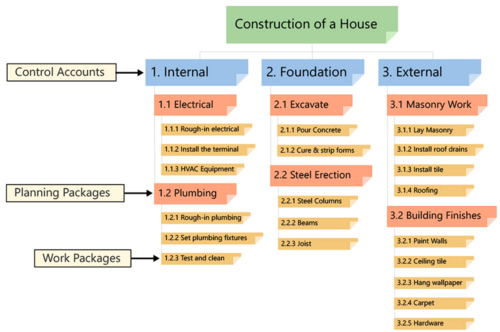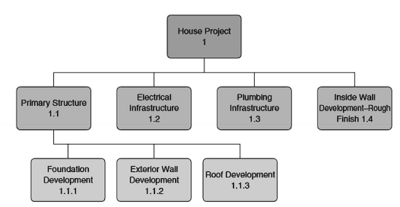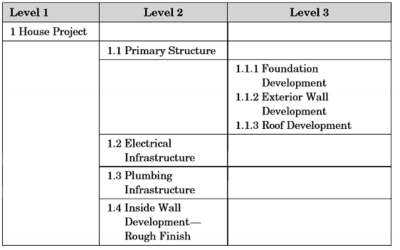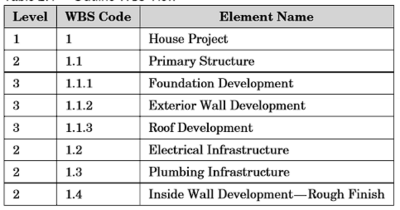(WBS) - Work Breakdown Structure
The WBS (work breakdown structure) is a process used in project management to identify the scope of a project and all the associated tasks that must be done to complete the project as defined. For this purpose, a results-oriented hierarchical decomposition of the work is carried out. This technology not only makes the work more accessible and manageable. It also enables the monitoring of different processes of a project, the estimation of costs and schedules and helps with team building. This led to WBS becoming one of the most important project management tools.
In the following, the author presents the different structuring techniques of a work breakdown structure. Furthermore, he describes the process of creating a work breakdown structure, the different forms of presentation as well as the advantages and limitations of a work breakdown structure and will illustrate these with examples
Contents |
Backgroud
As part of the U.S. Navy's fleet ballistic missile program (Polaris), the Program Evaluation and Review Technique (PERT) program was established in 1957 to address backlogs in planning. The program was designed to find a solution that would generate all the necessary tasks and efforts for the project based on its outcome. In 1962, the Department of Defense (DOD) and NASA published the first description of the work breakdown structure (WBS) with PERT as a model and later adopted it as the standard for the entire DOD product line. However, the first naming took place only in 1968. Beginning in 1987, the work breakdown structure (WBS) was first introduced by the Project Management Institute (PMI) with the PMBOK as a standard procedure for non-military operations, e.g., for applications in companies and other organizations and has been further developed by means of the introduction of a project charter since 1999. [1]
WBS in Project Management
A project is characterized by being temporary and providing a unique product, service or result. As each project in its entirety has never been done before, it involves a certain degree of uncertainty and risk. To counteract this, it is important that a project is planned comprehensively. This planning includes costs, resources, schedule, risks and the project scope with its specifically defined goals, objectives and deliverables. The WBS helps the planning team reduce the extent of uncertainty by breaking down the entire scope of the project into a series of smaller components making it more manageable and less overwhelming. [2] [3]
According to PMI, a WBS is defined as follows: "The WBS is a hierarchical decomposition of the total scope of work to be carried out by the project team to accomplish the project objectives and create the required deliverables. The WBS organizes and defines the total scope of the project and represents the work specified in the current approved project scope statement".[4] The WBS is used to explicitly describe the project scope, the deliverables and the outcome of a project. It answers the question of the "what ?" of the project. The processes that lead to the results, the "how ?", as well as the schedule witch determines the exact time of the production of a deliverable, the "when ?", are not answered by using a WBS. [5].
By using a WBS, the consistency and completeness of scope can be verified and duplicates of work or deliverables can be avoided. Furthermore, a WBS functions as a communication mechanism that helps to communicate the scope of work to all stakeholders involved in the project and create a shared understanding. Because project management communication has been proven to be one of the biggest influences on project success, the use of the work breakdown structure is an essential part of any project planning process, regardless of the project type, industry, project deliverables, or project life cycle type. After the creation of a WBS, the defined outcome can be used as a basis for defining further planning processes, such as defining activities, estimating costs and activity resources and identifying risks. Moreover, WBS establishes frameworks for the controlling and execution of the project's work.[2] Poorly executed WBS, on the other hand, can also lead to adverse project results including scope creep or unmanageable, frequently changing scope, unclear work assignments, ongoing, repeated project rescheduling and extensions, budget overrun, missed deadlines and unusable new products or delivered features. [6] [7]
WBS Structure
The structure of the WBS consists of a multi-level framework, whose elements are organized and represented graphically, presenting the deliverables and their component parts in a logical relationship. A project component is more precisely defined or subdivided at each descending level. Successive levels form a parent-child relationship [6] A typical WBS is structured as follows : [2]

- On the first level of the WBS the project name, product name or initiative name appears.
- The second level represents the project phases or the major project deliverables.
- The third level and levels below include all decomposed deliverables that are necessary to create the respective deliverables of the previous level.
- The Components of the last and lowest level of the WBS are called work packages.
- The number of levels depends on the size and complexity of the project.
Figure 1 illustrates an example of the structure of a WBS
Work Packages
As mentioned above, a work package is always placed in the lowest level of the WBS. A work package has a unique identifier that provides a structure for the hierarchical summation of resource information, cost, schedule, owners, milestones, risks and forms a code of accounts. Each work package can be assigned to a control account [4] [8]
Planning Packages
A Planning Package can be considered another type of work package. In case the scope of a project is defined, but the individual details are not yet available, planning packages are created. This is done to meet the 100% rule (explained in the "Fundamentals of WBS" section). As soon as the details are determined in the course of the project, a planning package develops into a work package.[8]
Control accounts
A control account is a management control point where the performance of WBS components is monitored and controlled. Here, for example, the budget, the scope or the schedule is integrated and compared with the current performance. Each control account can be assigned at least two or more work packages. [4]
WBS Dictionary
The WBS dictionary is a document that assists the WBS, providing detailed information about the activity, schedule and deliverables of all components in the WBS. This information is most likely delivered by other processes of project management. Further information that can be added but is the description of the work, assumptions and constraints, responsible organization, schedule milestones, associated schedule activities, resource and quality requirements, cost estimates, acceptance criteria, technical references, code of account identifier or agreement information. [4]
Fundamentals of the WBS
100% Rule
The 100% rule states that the top level of the WBS must cover the entire scope of the project in its entirety. In addition, each decomposition level of the WBS must contain all elements that constitute 100% of the parent available product.[8] [3]
Further WBS Rules
- A WBS has no limit of levels of decomposition. However, a parent level must always have at least two child components.
- The WBS elements do not: [5]
- contain cost
- are assigned resources.
- account for sequences or time
- show relationships
- imply importance
- overlap
How to Create a Work Breakdown
To create and use a WBS effectively:[9]
- Define the project and set boundaries: It is important to clearly establish the project and define its scope and its boundaries.
- Identify project deliverables: Once the scope and the boundaries are defined and described determine all high-level deliverables associated with the project.
- Create Level 2 components: Define level 2 components of the WBS and use the 100% rule to create them.
- Define Level 3 components: Break down each of the Level 2 elements. Apply the 100% rule at each level. Ask yourself at each subsequent level, whether a further breakdown would enhance the project management.
- Identify stakeholders: Assign a responsible person or team to each component.
- Create a Gant chart: A Gant chart can accompany a WBS, providing a time frame for activities and showing the progress of a project.
Approaches to creating the WBS
There are four traditional approaches to creating a WBS. These are top-down, bottom-up, standards and templates approach. [5]
Top-down
In the top-down approach, the team starts at level 1 of the WBS, identifying the final product. After that, the major deliverables that are required to achieve the desired product are defined and get decomposed until the final work packages are fixed. [5]
Bottom-up
The bottom-up approach starts with the work packages, the lowest level of the WBS. Here all deliverables must be grouped, consolidating all of the work toward the level 1 of the WBS wich represents the final product(s). To follow the bottom-up approach all work packages and deliverables must be defined before starting the grouping. With the help of the bottom-line approach, managers can make sure, that all work packages are included. [5]
Standards and Templates
Standards and templates are widely used in organizations as they are easy to use and ensure and improve consistency across all projects of an organization. In contrast, predefined standards and templates are also criticized because they reduce the creativity of the project manager. Furthermore, the voltages may not be suitable for every project, which is why adjustments have to be made. This can lead to deliverables that are not needed or work that is not included in the scope of the project being inadvertently included in the WBS. On the other hand, important components that are actually part of the project can be omitted, which leads to the fact that the 100% rule is no longer observed.[5]
Representation of WBS
There is no single or correct way to present WBS. Common representations include the tree structure, outline and tabular shown in the figure below. All three presentation forms describe the exact same WBS. Depending on the needs of the audience or the stakeholders present, the usage ridge of the different presentation forms varies from case to case. [2]



Benefits and Limitation of WBS
With the help of a WBS project planners can more easily identify the work and the specific tasks that make up the project's overall scope. Furthermore, the WBS can be used as a communication tool, that can give stakeholders an overview of the project at any level of detail. In addition, WBS provides a foundation for other project management tasks. The only disadvantage of the WBS is that it does not show how difficult the tasks are. Along with funding, you won't have access to the materials your team needs to execute. To use a work breakdown structure as efficiently as possible, it is advisable to use other tools in parallel.
Annotated Bibliography
Below, the titles of the most relevant references are given. The sources of the titles can be found in the reference list.
- Project Management Institute, Inc.. Practice standard for work breakdown structures. 2019 [2]
- - This book provides guidance and best practices for creating, using, and maintaining work breakdown structures (WBS) in project management. The book covers topics of WBS planning, development, decomposition, and verification, and includes examples and case studies to illustrate the concepts presented.
- 'Norman, S; Brotherton, S and Fried, R . Work Breakdown Structures: The foundation for project management excellence. 2008 [5]
- - The book focuses on the importance of creating effective work breakdown structures (WBS) as a critical component of successful project management
- Burghate, M. Work Breakdown Structure: Simplifying Project Management. 2008 [6]
- - The purpose of this article is to provides an overview of work breakdown structures (WBS) and their role in project management, including how to create and use them effectively. It also covers common challenges that project managers face when using WBS and provides strategies for overcoming them.
[1]
[4]
[7]
[8]
[5]
[2]
[6]
[9]
[3]
References
- ↑ 1.0 1.1 Eby, K (2016) Getting Started with Work Breakdown Structures (WBS) - https://www.smartsheet.com/getting-started-work-breakdown-structures-wbs
- ↑ 2.0 2.1 2.2 2.3 2.4 2.5 2.6 2.7 2.8 Project Management Institute, Inc (2019) Practice standard for work breakdown structures – Third edition, Newtown Square, Pennsylvania: Project Management Institute, Inc
- ↑ 3.0 3.1 3.2 Burek, P. (2013) The ABC basics of the WBS Paul Burek - Paper presented at PMI® Global Congress 2013—North America, New Orleans, LA. Newtown Square, PA: Project Management Institute
- ↑ 4.0 4.1 4.2 4.3 4.4 Project Management Institute, Inc (2017) A Guide to the PROJECT MANAGEMENT BODY OF KNOWLEDGE – Sixth edition, [direct quote p. 157], Newtown Square, Pennsylvania: Project Management Institute, Inc
- ↑ 5.0 5.1 5.2 5.3 5.4 5.5 5.6 5.7 Norman, S; Brotherton, S and Fried, R (2008) Work Breakdown Structures: The foundation for project management excellence – New Jersey: John Wiley & Sons, Inc
- ↑ 6.0 6.1 6.2 6.3 Burghate, M (2018) Work Breakdown Structure: Simplifying Project Management – Vol. 3, No. 2, International Journal of Commerce and Management Studies (IJCAMS)
- ↑ 7.0 7.1 Lester, E (2017) Chapter 12 - Work Breakdown Structures in Project Management, Planning and Control – Seventh edition, Oxford: Elsevier Butterworth-Heinemann, pages 53-59,
- ↑ 8.0 8.1 8.2 8.3 8.4 Swiderski, M (n.d.) Work Breakdown Structures (WBS) - https://www.workbreakdownstructure.com/
- ↑ 9.0 9.1 Organ, Christine (2022) How To Use Work Breakdown Structure As A Project Management Tool - https://www.nasdaq.com/articles/how-to-use-work-breakdown-structure-as-a-project-management-tool